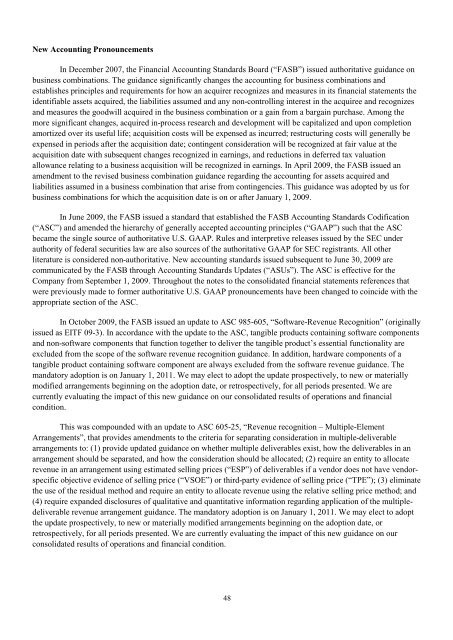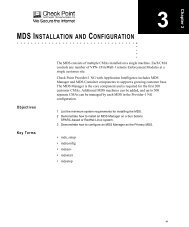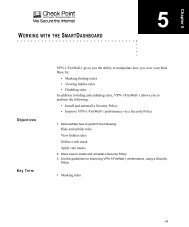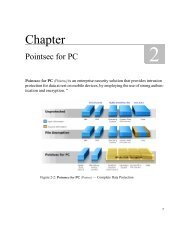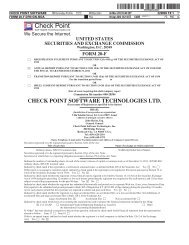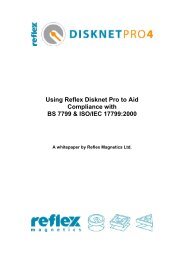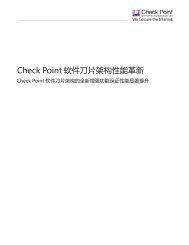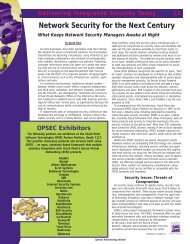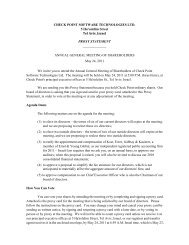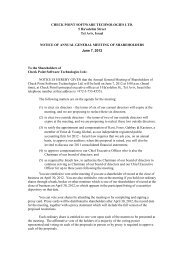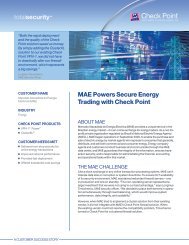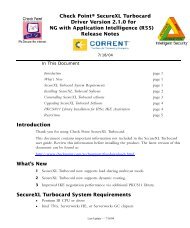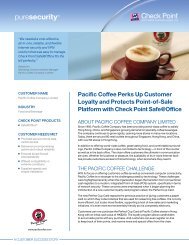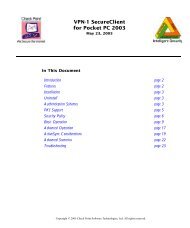FORM 20-F - Check Point
FORM 20-F - Check Point
FORM 20-F - Check Point
You also want an ePaper? Increase the reach of your titles
YUMPU automatically turns print PDFs into web optimized ePapers that Google loves.
New Accounting Pronouncements<br />
In December <strong>20</strong>07, the Financial Accounting Standards Board (“FASB”) issued authoritative guidance on<br />
business combinations. The guidance significantly changes the accounting for business combinations and<br />
establishes principles and requirements for how an acquirer recognizes and measures in its financial statements the<br />
identifiable assets acquired, the liabilities assumed and any non-controlling interest in the acquiree and recognizes<br />
and measures the goodwill acquired in the business combination or a gain from a bargain purchase. Among the<br />
more significant changes, acquired in-process research and development will be capitalized and upon completion<br />
amortized over its useful life; acquisition costs will be expensed as incurred; restructuring costs will generally be<br />
expensed in periods after the acquisition date; contingent consideration will be recognized at fair value at the<br />
acquisition date with subsequent changes recognized in earnings, and reductions in deferred tax valuation<br />
allowance relating to a business acquisition will be recognized in earnings. In April <strong>20</strong>09, the FASB issued an<br />
amendment to the revised business combination guidance regarding the accounting for assets acquired and<br />
liabilities assumed in a business combination that arise from contingencies. This guidance was adopted by us for<br />
business combinations for which the acquisition date is on or after January 1, <strong>20</strong>09.<br />
In June <strong>20</strong>09, the FASB issued a standard that established the FASB Accounting Standards Codification<br />
(“ASC”) and amended the hierarchy of generally accepted accounting principles (“GAAP”) such that the ASC<br />
became the single source of authoritative U.S. GAAP. Rules and interpretive releases issued by the SEC under<br />
authority of federal securities law are also sources of the authoritative GAAP for SEC registrants. All other<br />
literature is considered non-authoritative. New accounting standards issued subsequent to June 30, <strong>20</strong>09 are<br />
communicated by the FASB through Accounting Standards Updates (“ASUs”). The ASC is effective for the<br />
Company from September 1, <strong>20</strong>09. Throughout the notes to the consolidated financial statements references that<br />
were previously made to former authoritative U.S. GAAP pronouncements have been changed to coincide with the<br />
appropriate section of the ASC.<br />
In October <strong>20</strong>09, the FASB issued an update to ASC 985-605, “Software-Revenue Recognition” (originally<br />
issued as EITF 09-3). In accordance with the update to the ASC, tangible products containing software components<br />
and non-software components that function together to deliver the tangible product’s essential functionality are<br />
excluded from the scope of the software revenue recognition guidance. In addition, hardware components of a<br />
tangible product containing software component are always excluded from the software revenue guidance. The<br />
mandatory adoption is on January 1, <strong>20</strong>11. We may elect to adopt the update prospectively, to new or materially<br />
modified arrangements beginning on the adoption date, or retrospectively, for all periods presented. We are<br />
currently evaluating the impact of this new guidance on our consolidated results of operations and financial<br />
condition.<br />
This was compounded with an update to ASC 605-25, “Revenue recognition – Multiple-Element<br />
Arrangements”, that provides amendments to the criteria for separating consideration in multiple-deliverable<br />
arrangements to: (1) provide updated guidance on whether multiple deliverables exist, how the deliverables in an<br />
arrangement should be separated, and how the consideration should be allocated; (2) require an entity to allocate<br />
revenue in an arrangement using estimated selling prices (“ESP”) of deliverables if a vendor does not have vendorspecific<br />
objective evidence of selling price (“VSOE”) or third-party evidence of selling price (“TPE”); (3) eliminate<br />
the use of the residual method and require an entity to allocate revenue using the relative selling price method; and<br />
(4) require expanded disclosures of qualitative and quantitative information regarding application of the multipledeliverable<br />
revenue arrangement guidance. The mandatory adoption is on January 1, <strong>20</strong>11. We may elect to adopt<br />
the update prospectively, to new or materially modified arrangements beginning on the adoption date, or<br />
retrospectively, for all periods presented. We are currently evaluating the impact of this new guidance on our<br />
consolidated results of operations and financial condition.<br />
48


